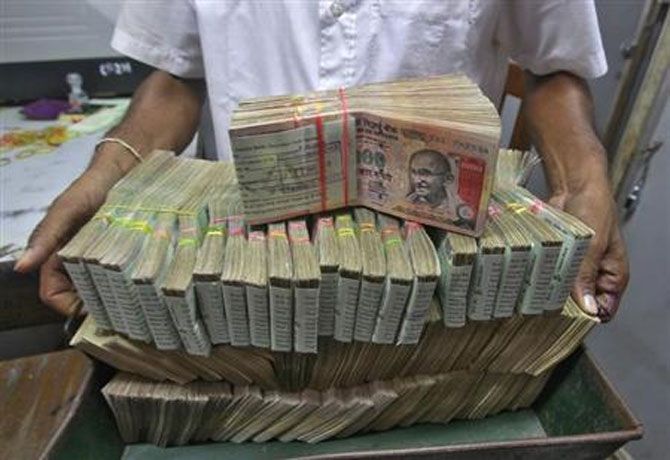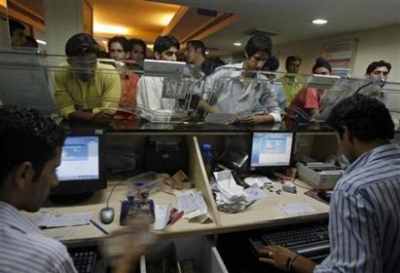Foreign exchange reserves as a percentage of India's total external debt were 73 per cent at the end of December 2015.

India's external debt profile appears to have improved somewhat, if the data for the period ended December 2015 are taken into account.
The overall external debt stock stood at $480 billion, showing a small one per cent increase over $475 billion as at the end of March 2015.
Compare it with the external debt level at the end of December 2014, and the increase is a little higher at 4.66 per cent.
This is the smallest increase at least in the last five years - when the average annual rise in external debt has ranged between eight and 18 per cent.
Look at it from a longer-term perspective, and the situation will indeed appear relatively stable on this front.
Foreign exchange reserves as a percentage of India's total external debt were 73 per cent at the end of December 2015.
They may be well below the comfortably high levels of over 100 per cent seen between 2003-04 and 2009-10, but at the same time they are also nowhere near the precariously low levels of seven or 11 per cent that India experienced during its worst balance of payments crisis in 1990-91 and 1991-92.
Similarly, the government's principal and interest payments liability as a percentage of export earnings, or the debt service ratio, has also stayed at a low level of 7.5 per cent in 2014-15.
Compare this with the 30-35 per cent debt service burden from 1990 to 1992 and you will see the reason why there is a reduced level of stress for those who manage the country's balance of payments.
Even the level of external debt as a percentage of India's gross domestic product or GDP is now at less than 24 per cent, while it had reached a high of 38 per cent in 1991-92.
The story of India's external debt, however, changes a little if you take a close look at its changing composition in the last 25 years.
Three clear periods with distinct trends emerge, particularly with regard to the accumulation of India's short-term debt.
From 1990-91 to 2003-04, short-term debt with original maturity of one year or less kept declining, both as a percentage of foreign exchange reserves and of total external debt.
In 1990-91, short-term debt was as much as 146 per cent of India's foreign exchange reserves and it declined to as low as 3.9 per cent by the end of 2003-04.
Similarly, the share of short-term debt in total external debt declined from 10 per cent in 1990-91 to 3.9 per cent in 2003-04.
The second phase begins from 2004-05 and ends with 2012-13. This is a period when short-term debt sees a spike.
From levels of 12.5 per cent of foreign exchange reserves and 13.2 per cent of total external debt in 2004-05, short-term debt rose to 33.1 per cent and 23.6 per cent, respectively, by the end of 2012-13.
Remember that this is a period in which economic growth had picked up a healthy pace, clocking an annual average rate of eight per cent.
This was much higher than the 5.7 per cent annual average economic growth seen in the 14 years between 1990-91 and 2003-04.
The third phase begins in 2013-14 with short-term debt once again declining.
In this period, the share of short-term debt in foreign exchange reserves as well as total external debt has fallen consistently from 30.1 per cent and 20.5 per cent, respectively, in 2013-14 to 23.3 per cent and 17 per cent by the end of December 2015.
Annual average economic growth in this period (including 2015-16) is estimated at around seven per cent.
Note that the three periods pertain to three distinct phases of political governance.
In the first period - between 1990-91 and 2003-04, the governments of P V Narasimha Rao, H D Deve Gowda, Inder Kumar Gujral and Atal Bihari Vajpayee rescued the country from an economic crisis and placed it on what turned out to be a broadly irreversible path of economic reforms.
In the second phase, the government of Manmohan Singh rode on the reforms initiated in the previous decade and a half, but used the resultant growth and higher revenues to unveil a series of measures to increase entitlements by way of rural jobs and education among other things.
The third phase began just before the Narendra Modi government was formed and is now focused on the need to usher in greater reforms and revive industrial growth.
It is difficult to establish a correlation between the trends in short-term debt in these three periods and the distinct governance style followed by the governments in those respective periods. But the broad trends cannot be ignored.
Take a shorter time frame of five years and the trends are even more interesting.
If short-term debt is falling as a percentage of total external debt, what has kept the overall debt profile growing is obviously long-term debt. But here also the composition of long-term debt is seeing a slightly disturbing change. Its reliance on multilateral loans is declining - from about 16 per cent in 2010 to about 11 per cent now.
Even the share of export credit in overall debt is falling from over six per cent to barely three per cent - an indication perhaps of how the exports sector has fallen on bad days.
But the big change in India's long-term debt profile is with regard to its commercial borrowings and deposits from non-resident Indians or NRIs.
Commercial borrowings accounted for 27 per cent of India's total external debt in 2010 and they have risen to over 38 per cent by the end of December 2015.
Similarly, NRI deposits accounted for 18 per cent of external debt five years ago. Today, they have a share of 24 per cent.
The growth in short-term debt has slowed, but commercial borrowings and NRI deposits seem to be booming.
Whether that is a healthy shift, only experts and time will tell.











